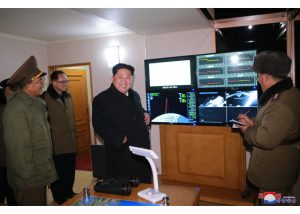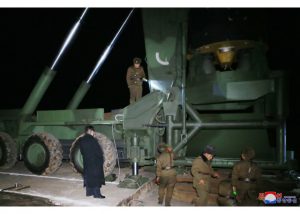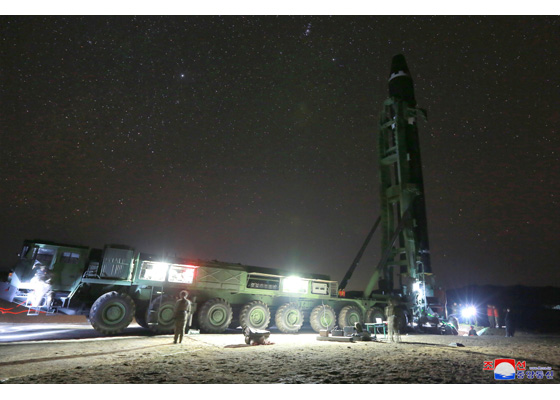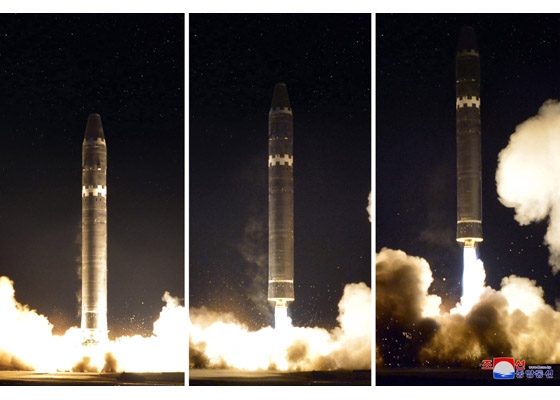The New Hwasong-15 ICBM: A Significant Improvement That May be Ready as Early as 2018

Photographs and video released by North Korea reveal that the Hwasong-15 test fired on November 29 is not a modified version of the Hwasong-14, as initially assessed here based solely on flight data. The Hwasong-15 is considerably larger than the Hwasong-14, and initial calculations indicate the new missile could deliver a moderately-sized nuclear weapon to any city on the US mainland. The Hwasong-15 is also large and powerful enough to carry simple decoys or other countermeasures designed to challenge America’s existing national missile defense (NMD) system. A handful of additional flight tests are needed to validate the Hwasong-15’s performance and reliability, and likely establish the efficacy of a protection system needed to ensure the warhead survives the rigors of atmospheric re-entry.

The Hwasong-15 is a two-stage, liquid-fueled ICBM. Photographs of the Hwasong-15 reveal that its first stage is powered by a pair of engines that share the same external features found on the single chamber engine used by the Hwasong-14. The two-chamber configuration found on the Hwasong-15 is very similar to the original design of the RD-251 engine block developed and produced in the former Soviet Union, suggesting that the total thrust generated at lift-off is about 80-tons force. This is reasonably consistent with the estimated mass of the new missile, which is between 40 and 50 metric tons. The configuration of the second stage is not known, though its overall size suggests it contains 50 percent more propellant than the Hwasong-14. Taken together, and applying conservative assumptions about the second-stage propulsion system, it now appears that the Hwasong-15 can deliver a 1,000-kg payload to any point on the US mainland. North Korea has almost certainly developed a nuclear warhead that weighs less than 700 kg, if not one considerably lighter.
The missile also features a new steering mechanism that is more efficient and simpler than the methods used in North Korea’s other missiles. North Korea’s older, Scud-based missiles employed jet vanes for steering during the boost phase. The Hwasong-12 and -14 used four small engines mounted in parallel to the main thrust chamber for missile control during first stage operations. North Korean engineers have mounted each of the main engines of the Hwasong-15 on a slotted gimbal that allows each to be reoriented in one dimension to control the direction of the exhaust gases to provide control.
Little is known about the construction of the second stage. Most likely it is powered by four small engines derived from the Soviet R-27 missile. Such an arrangement would mean the upper-stage is underpowered, when compared to ICBMs fielded by other nations, but it would not prevent the Hwasong-14 from being used to threaten the entire US. Less likely, but possible, North Korea has obtained a new engine for use on the second-stage. Its inclusion in the design would enhance the Hwasong-15’s capabilities.
The Hwasong-15 also incorporates other important qualitative improvements. It could be fitted with a post-boost control system to make final adjustments to the payload’s velocity and position in space, a measure that could substantially improve the missile’s precision. It is also possible that the missile has been designed to carry simple decoys, or other countermeasures, to confuse the US missile defense system. The missile has the throw-weight capacity to carry the countermeasures along with the warhead, but it is far from certain these were included in this most recent flight test.
The appearance of the Hwasong-15 marks a significant improvement in North Korea’s ability to target the US. How many more tests North Korea will undertake depends on the regime’s perceived needs. At least one or two more tests on a standard trajectory are needed to validate its performance as a ballistic missile. Additional flight tests should be performed to determine the missile’s reliability, establish its accuracy and verify the re-entry protection system. However, if low confidence in the missile’s reliability is acceptable, two or three test firings over the next four to six months may be all that is required before Kim Jong Un declares the Hwasong-15 combat ready.


